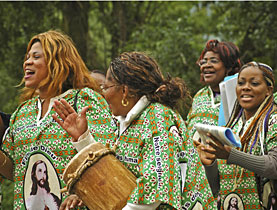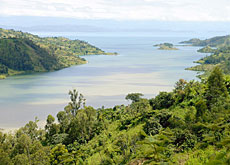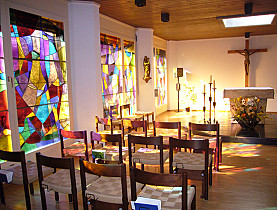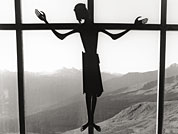Africans beat a path to St Maurice

On one day in June every year Africans from across Switzerland descend on St Maurice, a tourist town squeezed between high cliffs on the banks of the River Rhône.
In traditional and not-so-traditional dress, beating African drums or pushing babies in strollers, they come to venerate the saint after whom the town is named – a third century martyr whose remains lie in the abbey.
Maurice, a Christian and an officer of the Roman army from Upper Egypt, is said to have been executed here along with one in ten of his men for defying an order to take up arms against civilians.
While he may have been one of the first African martyrs, he was certainly not the last. The remains of 19th century Ugandan Christians killed for refusing to renounce their faith were in recent times brought to the abbey to rest alongside those of Maurice and his companions.
The African pilgrimage has been going for just seven years, and is growing in popularity.
In the first year 100 people turned up. This year more than 500 people – including Swiss Catholics – took part in the ceremony to venerate the saints and a procession to the Abbey of St Maurice for a service of worship.
It was a noisy, joyful affair with around ten choirs contributing songs from Cameroon, Cape Verde, DR Congo and Rwanda accompanied by tam-tams and balafons – a kind of large xylophone.
“The music really touches something deep in me,” enthused Ellen Mary Dreier, a South African who has been living in Switzerland for 27 years. A first-time participant in the pilgrimage, she said she had come because “It’s an occasion to know more about my Christian roots.”
“It’s like Pentecost, with everyone speaking his own language, although French is the common denominator,” said Brother Maurice Leiggener of the White Fathers’ African missionary order that launched the pilgrimage in 2002.
“People come from Zurich, Lucerne, Jura, Lausanne… What they have in common, apart from their faith, is the pleasure of meeting together. It’s amazing, something unique bringing together young and old.”
Women martyrs
Respect for their ancestors is an important part of African culture and also of the pilgrimage. Participants assembled at Vérolliez – close to the town St Maurice and the supposed site of the saint’s martyrdom – and heard accounts not just of Maurice’s sacrifice but of those of two other young African Christians at the start of the third century.
Rogo Koffi Fiangor from Togo related the gruesome tale of Perpetua and Felicity who lived in Carthage, now in Tunisia, but then part of the Roman empire.
The women – one had just given birth and the other was still breastfeeding her baby – were denounced for refusing to sacrifice to the gods for the emperor’s health. They were dragged to the circus where they were set upon by famished wild beasts. The crowd were so impressed by their courage in standing up to the animals that they called for the women to be spared. “Spared” in this case meant they were finished off with the sword.
But neither the grim reminder of continuing persecution in some parts of the world nor the heavy skies succeeded in putting a dampener on the festive atmosphere. Spontaneous singing and dancing broke out after lunch – a shared picnic of fish fritters, stew and rice.
“In terms of faith, they bring a sense of celebration, something we’ve lost a bit, a convivial, family type of celebration,” commented Brother Maurice. “It’s something peculiarly African.”
Come, let’s share!
This year Swiss Christians were encouraged to take part in the pilgrimage, in an effort to improve understanding and show that “Africa has more to offer the world than poverty”, according to co-organiser Hyacinthe Nguezi Ya Kuiza. The theme was “Come, let’s share!”
“Africa doesn’t come with empty hands. It also has riches to offer other churches and humanity,” he said.
Speaking on behalf of the St Maurice tourist office, Jean-Marie Torrenté welcomed the pilgrims and alluded to the difficulties many foreigners face in Switzerland.
“The difference between you [Africans] and us still frightens some of my compatriots a little,” he said, in reference to the nationwide vote on naturalisation being held as the pilgrimage took place on June 1.
A loud cheer went up when the organisers announced the result of the vote: a round rejection of the proposal, which would have made it harder for foreigners to obtain Swiss citizenship.
swissinfo, Morven McLean in St Maurice
St Maurice is situated at the point where the narrowing of the River Rhône prompted the Romans to build a bridge.
The Romans named it Agaune. Previously the area was known by the celtic name Acauno.
Because of its strategic location on the route from Rome to Gaul, numerous Roman legions passed through the area.
Maurice, the leader of one of these, was put to death with his men at the end of the third century.
A shrine was built at the foot of a cliff in 390 to house the tomb of the saint. It was replaced by a monastery in 515 – the oldest surviving abbey north of the Alps.
Pilgrims have been coming to the abbey church for close to 1,500 years, bringing gifts of gold and silver. The church treasury contains items of fine workmanship including the Casket of Teuderic, an embossed silver bust of St Candidus and a Roman saronyx vase.
St Maurice has given his name to two countries (Mauritius and Mauritania) and dozens of towns around the world.

In compliance with the JTI standards
More: SWI swissinfo.ch certified by the Journalism Trust Initiative



You can find an overview of ongoing debates with our journalists here. Please join us!
If you want to start a conversation about a topic raised in this article or want to report factual errors, email us at english@swissinfo.ch.